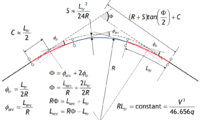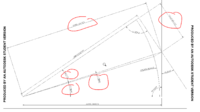General Case: (including two transition curves, same properties, and a circular arc).

Problem:
Two straight roads are to be linked by a wholly transitional curve (via clothoid spiral curves).
q1 = known, q2 = known, R = known, Larc = 0, V = known, phi = known.
What is the distance AO:

Note the above figure is not the actual problem layout.
I understand this question is not simple geometry, it is to do with road design. However the solution can be found using geometry of course. Typically in the symmetric transition curve and circular arc case you could just do (R+S)tan(phi/2) and then pythagoras to find the distance AO. But the S values differ in the asymmetric case, and doing phi/2 does not work here.
Hopefully this makes sense, its very hard to explain and even harder to try figure out personally.

Problem:
Two straight roads are to be linked by a wholly transitional curve (via clothoid spiral curves).
q1 = known, q2 = known, R = known, Larc = 0, V = known, phi = known.
What is the distance AO:

Note the above figure is not the actual problem layout.
I understand this question is not simple geometry, it is to do with road design. However the solution can be found using geometry of course. Typically in the symmetric transition curve and circular arc case you could just do (R+S)tan(phi/2) and then pythagoras to find the distance AO. But the S values differ in the asymmetric case, and doing phi/2 does not work here.
Hopefully this makes sense, its very hard to explain and even harder to try figure out personally.

